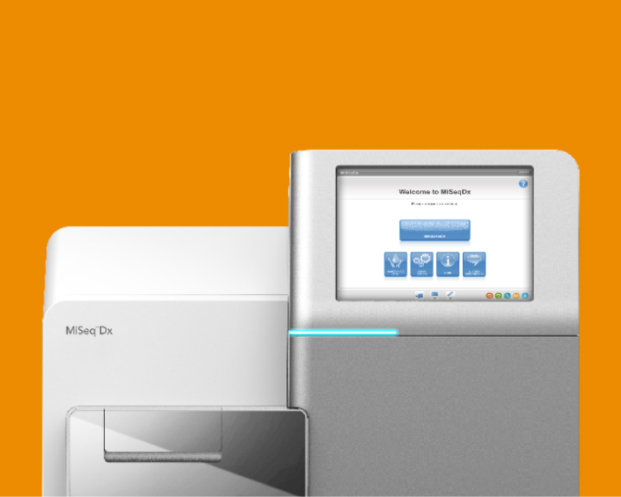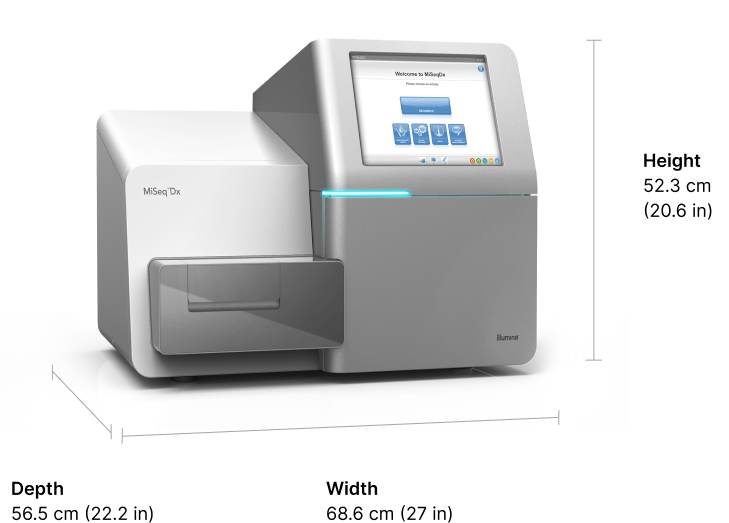| Read length | MiSeqDx Reagent Kit v3 |
|---|---|
| 2 x 150 bp | ≥ 5 Gb |
MiSeqDx Instrument specifications
Validated performance. Reliable results.
A powerful benchtop sequencing system that delivers exceptional data quality and reliability for IVD assay testing, development, and clinical research

Output per flow cell for various read lengthsa
a. The MiSeqDx Instrument runs a single flow cell. Output per flow cell and output per run are the same.
Estimated sample throughput for key applications
| Sample type | MiSeqDx Reagent Kit v3 |
|---|---|
| Human peripheral whole blood for cystic fibrosis testing | 24-96 samples per run |
Reads passing filter per flow cell
| Sample type | MiSeqDx Reagent Kit v3 |
|---|---|
| Paired-end reads | ≥ 15M |
Quality scoresa
| Read length | MiSeqDx Reagent Kit v3 |
|---|---|
| 2 x 150 bp | ≥ 80% of bases higher than Q30 |
a. A quality score (Q-score) is a prediction of the probability of an error in base calling. The percentage of bases > Q30 is averaged across the entire run.
Run time
| Read length | MiSeqDx Reagent Kit v3 |
|---|---|
| 2 x 150 bp | 24 hr |
Total overall accuracy
| Variant calling | Accuracy |
|---|---|
| Germlinea | > 99.9% overall percent agreement to reference results |
| Somatica | 100% overall percent agreement to reference result |
a. Results based on a representative TruSeq Amplicon–based assay designed to query a variety of genes covering 12,588 bases across 23 different chromosomes using 150 amplicons.
Total overall reproducibility
| Variant calling | Accuracy |
|---|---|
| Germlinea | 99.88% overall percent agreement to reference results |
| Somaticb | 99.6% percent expected call for mutant sample |
a. Results based on TruSight Cystic Fibrosis 139-Variant Assay.
b. Results based on a representative 2-gene TruSeq Amplicon-based assay.
Instrument specifications

MiSeqDx specifications
-
Light emitting diode (LED)
Wavelengths520 nm, 660 nm
-
Dimensions
W x D x H68.6 cm × 56.5 cm × 52.3 cm
(27.0 in × 22.2 in × 20.6 in) -
Dry weight
54.5 kg (120 lb)
-
Crated weight
90.9 kg (200 lb)
Specifications shown here are for IVD use. View research use only specifications, applicable when running the MiSeqDx Instrument in Research Mode.
Key technologies
Sequencing by synthesis chemistry
The MiSeqDx Instrument harnesses proven Illumina sequencing by synthesis (SBS) chemistry to deliver accurate data and robust performance. SBS chemistry uses reversible-terminator fluorescently labeled nucleotides to detect single bases as they are incorporated into growing DNA strands, reading billions of sequences in parallel.
The MiSeqDx Instrument incorporates paired-end sequencing that enables both ends of the DNA fragment to be sequenced. Because the distance between each paired read is known, alignment algorithms can use this information to map the reads. This is especially helpful across difficult-to-sequence, repetitive regions of the genome.
Intended use for the MiSeqDx Instrument
United States:
The MiSeqDx Instrument is intended for targeted sequencing of DNA libraries from human genomic DNA extracted from peripheral whole blood, formalin-fixed, paraffin-embedded (FFPE) tissue, or embryonic tissue, when used with in vitro diagnostic (IVD) assays performed on the instrument. The MiSeqDx Instrument is not intended for whole genome or de novo sequencing. The MiSeqDx Instrument is to be used with registered and listed, cleared, or approved IVD reagents and analytical software.
European Union/other:
The MiSeqDx Instrument is intended for targeted sequencing of DNA libraries from human genomic DNA extracted from peripheral whole blood or formalin-fixed, paraffin-embedded (FFPE) tissue, when used with in vitro diagnostic (IVD) assays performed on the instrument. The MiSeqDx Instrument is not intended for whole genome or de novo sequencing. The MiSeqDx Instrument is to be used with registered and listed, cleared, or approved IVD reagents and analytical software.